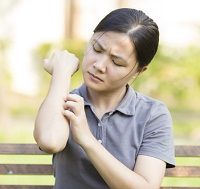Article
Investigators Assess Eczema Control, Itch Intensity Tools
Author(s):
The Recap of Atopic Eczema (RECAP) and Atopic Dermatitis Control Tool (ADCT) were recommended to measure eczema control.

A team of voters have assessed several tools for measuring and assessing itch intensity for patients with atopic eczema.
A team, led by Yael A. Leshem, MD, MCR, Division of Dermatology, Rabin Medical Center, recommended instruments to measure eczema control and itch intensity in patients with atopic eczema in clinical practice.
“Measuring outcomes in clinical practice can aid patient care, quality improvement, and real-world evidence generation,” the authors wrote.
Tools to Measure Itch
However, a list of validated, feasible instruments to measure atopic eczema in clinical care is currently being developed by the Harmonising Outcome Measures for Eczema (HOME) Clinical Practice initiative and the Patient-Oriented Eczema Measure (POEM) and the Patient-Oriented Scoring Atopic Dermatitis Index (PO-SCORAD) are recommended by consensus to measure symptoms in clinical practice.
However, there is a need for instruments that measure itch intensity.
The HOME Group previously decided that long-term control should be captured using repeated measurements of eczema control, but recommended instruments to measure eczema control in clinical practice have not yet been defined.
Testing the Instruments
In the study, the investigators identified available instruments to measure eczema control and itch intensity through systematic reviews, informing a consensus process held at the HOME VIII virtual online meeting between October 6-9, 2020. They highlighted feasibility aspects to optimize instrument selection for clinical practice.
Consensus was considered for an instrument if fewer than 30% of voters disagreed.
There were 7 instruments identified, with the Recap of Atopic Eczema (RECAP) and Atopic Dermatitis Control Tool (ADCT) recommended to measure eczema control (n = 3; 5%; n = 7; 10% of voters disagreed, respectively).
A single-question patient global assessment also had support, but the current available instrument did not reach consensus. There were 6 available itch-intensity instruments identified.
Half of the 6 were recommended by consensus—a peak 24-hour numeric rating scale (NRS)-itch, and 1-week NRS-itch instruments from the Patient-Reported Outcomes Measurement Information System (PROMIS) Itch Questionnaire, measuring average and peak itch (n = 11; 17%, n = 14; 22%, and n = 16; 27% voters disagreed, respectively).
“Clinicians and patients are encouraged to incorporate these well-validated, quick-to-perform, and easy-to-use instruments into their clinic, selecting the instruments that best fit their need,” the authors wrote. “These assessments are meant to enhance, not replace, the patient–clinician encounter, and to support real-world research and health care improvement.”
Itch Intensity
Earlier this year, investigators found itch intensity peaks in the evening for pediatric patients with atopic dermatitis (AD).
A team, led by Brian Cheng, Northwestern University Feinberg School of Medicine, identified the differences in itch intensity among pediatric patients with atopic dermatitis.
In previous research, investigators found itch associated with atopic dermatitis varies greatly by the time of day for adults. However, it is not entirely understood what the variation of itch intensity throughout the day is among pediatric patients with atopic dermatitis.
Overall, 83% of the pediatric patients had moderate-to-severe atopic dermatitis based on the Patient-Oriented Eczema Measure.
The investigators found the worst itch most frequently occurred at 7:00 pm on weekdays and 8:00 pm on weekends, with a mean worst itch of 2.7 and 3.0 hours prior to sleep onset on weekdays and weekends, respectively. Itch intensity was also higher in the evening (mean: 5.6 vs 5.4; t = 2.61; P = 0.01). This was even higher at bedtime (5.8 vs. 5.4; t = 4.58; P <.0001) compared to the itch intensity for all other times of day.
The study, “Measuring Atopic Eczema Control and Itch Intensity in Clinical Practice,” was published online in JAMA Dermatology.





